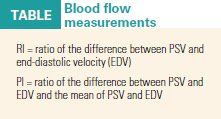Blood flow on color Doppler sonography predicts breast tumor response to neoadjuvant chemotherapy
The low-cost imaging technique has value for determining the relative aggressiveness of inflammatory and advanced disease.
ABSTRACT: The low-cost imaging technique has value for determining the relative aggressiveness of inflammatory and advanced disease.
Tumor flow velocity measured on color Doppler ultrasound may serve as an independent marker of disease-free survival in breast cancer patients undergoing neoadjuvant chemotherapy.
The imaging modality offers an inexpensive and convenient alternative to more expensive biomarker testing studies, according to international researchers.
Gurpreet Singh, PhD, and colleagues investigated the role of color Doppler sonography in evaluating changes in blood flow velocity in locally advanced and inflammatory breast cancer, both before and after treatment. Their goal was to monitor the response to therapy and identify possible correlations between survival and various Doppler indices.
Circulating tumor cells continue to prove mettle
Previous studies have shown that the presence of five or more circulating tumor cells (in 7.5 ml of blood) can serve as a sign of poor prognosis in women with advanced breast cancer.
Maria Sandri, MD
, and colleagues at the European Institute of Oncology in Milan tested their hypothesis that the presence of circulating tumor cells in early breast cancer might predict an increased risk for relapse. CTCs could also serve as an early marker for treatment efficacy, they said.
For this study, 30 mm of peripheral blood was taken from 56 breast cancer patients before surgery and five days after surgery. If the evaluation for the presence of CTCs came up positive, another sample was taken after 30 days. One to three CTCs were found in 29% of 56 patients before surgery, in 30% of 47 patients at day five, and in 30% of 27 patients at day 30 (
Ann Surg Oncol
online, February 5, 2010).
They found that approximately 30% of the patients with localized breast cancer had CTCs present before and after surgery and that CTC measurements changed from positive to negative in 40% of the cases. The authors saw no association between pathological characteristics and CTC measurements apart from a borderline significant association between the presence of CTCs at baseline and vascular invasion (
P
= .07).
Dr. Singh is from the medical physics unit at the All India Institute of Medical Sciences in New Delhi. Study co-authors are from the institute's departments of surgery and radiology and the University of Greifswald in Germany.
For this research, 50 patients with biopsy-proven breast carcinoma were treated with standard chemotherapy protocols. Before treatment, the patients underwent color Doppler ultrasound with a 5 MHz linear-array probe. A radiologist evaluated the images for blood flow using the following intratumoral Doppler indices: resistive index (RI), pulsatile index (PI), and peak systolic velocity (PSV; see Table).
Changes in the percentage in RI, PI, and PSV were individually evaluated after three cycles of chemotherapy but before surgery. The patients were followed for 24 months after all treatment, including surgery and radiation therapy, according to an article in the European Journal of Radiology online, January 11, 2010.
PSV uptick signals recurrence
According to the results, all 50 patients had hypervascular signals on pretherapy color Doppler ultrasound studies. At the time of presentation, the mean value of RI was 0.89, the mean value of PI was 10.65, and the mean value of PSV was 22.15.

After treatment, RI decreased in 54% of the patients, while PI decreased in 40%. RI increased in 46% of the patients, and PI increased in 60%. Neither RI nor PI correlated with clinical response, the authors wrote.
The authors reported that 11 out of 16 patients with an uptick in PSV after chemotherapy had ipsilateral recurrence, contralateral disease, locoregional disease recurrence, and/or distant metastasis compared with the five patients who had decreased PSV after treatment.
"The difference in disease-free survival was found to be significant between the group in which PSV increased and that in which PSV decreased (P < .05)...disease-free survival was longer in patients in whom PSV decreased after chemotherapy compared with those in whom PSV increased," they said. Also, RI, PI, and PSV disappeared in patients who achieved complete response to treatment.
Dr. Singh and colleagues cautioned that sonographic results may be not as accurate in patients with ill-defined lesions that do not have clearly visible tumor margins. Also, ultrasound exams are very operator-dependent; in this study, all exams were done by radiologists, Dr. Singh told Oncology News International.
However, Dr. Singh and colleagues suggested that the modality was "economical and uniquely beneficial" in a routine clinical setting.
VANTAGE POINT Adding to the armamentarium for response evaluation

This is a study of practical significance, said Dr. Kumar, a professor based in the department of surgery at the Institute of Medical Sciences at Banaras Hindu University in Varanasi, India. "The study validates earlier studies related to the use of color Doppler as an independent tool for assessment of the response to chemotherapy in locally advanced breast cancer."
Dr. Kumar and colleagues authored a study that found that Doppler scoring can be used to objectively predict the response to chemotherapy in patients with locally advanced breast cancer and that the imaging modality correlates well with histopathological response (World J Surg Oncol 5:99, 2007).
"The [current] research adds to our armamentarium of response evaluation criteria in patients undergoing primary chemotherapy. I think such an approach could be exploited universally by oncologists practicing chemotherapy for breast cancer. This would be a cost-effective approach in this direction," Dr. Kumar said.
However, he added that "the authors should also make efforts to correlate the chemotherapy response with the gold standard, histological response. Then only a significant conclusion could be better drawn."
"Also there is room for evaluating more objective indices, such as Doppler scoring, comprehensively. A multicenter trial is very much needed," Dr. Kumar said.